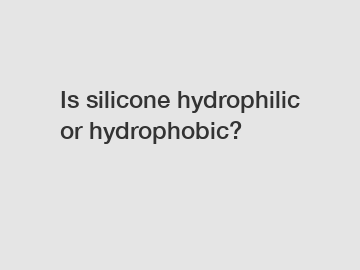Dec. 29, 2023
Chemicals
Goto KDOCEL to know more.
Is silicone hydrophilic or hydrophobic?
Silicone is a versatile and commonly used material in many industries. It has various uses due to its unique properties and is often found in medical devices, household products, and even personal care items. When it comes to its interaction with water, the question arises: Is silicone hydrophilic or hydrophobic? To understand this distinction, let's delve into the characteristics of silicone and its interaction with water.

Hydrophilic vs. Hydrophobic.
Before we address whether silicone is hydrophilic or hydrophobic, let's define these terms. Hydrophilic materials have an affinity for water and tend to absorb or dissolve in it easily. On the other hand, hydrophobic materials repel water and do not mix well with it. Understanding these distinctions is crucial in determining how silicone behaves in the presence of water.
Silicone Properties.
Silicone is a synthetic polymer made up of silicon, oxygen, carbon, and hydrogen atoms. Its molecular structure contributes to its unique properties. Silicone is known for its excellent thermal stability, flexibility, and resistance to chemicals. However, its hydrophobic or hydrophilic characteristics depend on the specific type of silicone and its surface properties.
Hydrophilic Silicone.
Certain types of silicone can be altered to become hydrophilic. These modifications involve surface treatments that introduce hydrophilic properties to the material. Hydrophilic silicone can absorb water or allow it to spread evenly across its surface without repelling it. This characteristic makes it useful in applications such as medical implants, contact lenses, and wound dressings.
Hydrophobic Silicone.
By default, silicone is considered hydrophobic, meaning it repels water. The molecular structure of silicone creates a surface that is impermeable to water molecules. This property is beneficial in applications where water or moisture resistance is important, such as in electrical insulation, sealants, and waterproof coatings. Hydrophobic silicone also prevents water absorption, thus reducing the risk of microbial growth in certain products.
Applications and Considerations.
Understanding whether silicone is hydrophilic or hydrophobic is essential in determining its suitability for various applications. Hydrophilic silicone is preferred in medical devices, as it allows better compatibility with bodily fluids and tissues. Hydrophobic silicone, on the other hand, is more suitable for waterproofing or moisture-resistant applications.
Many factors can influence the hydrophilic or hydrophobic nature of silicone, including its formulation, additives, and surface treatments. Manufacturers can alter the properties of silicone through chemical modifications or coatings to achieve their desired characteristics.
Conclusion.
In conclusion, the hydrophilic or hydrophobic nature of silicone depends on specific modifications, treatments, or coatings applied to it. By default, silicone is hydrophobic, but it can be altered to become hydrophilic through various techniques. Understanding the hydrophilic or hydrophobic characteristics of silicone is crucial in selecting the right material for a particular application.
If you have further questions about the hydrophilic or hydrophobic properties of silicone or require assistance in choosing the appropriate silicone material for your specific needs, please do not hesitate to contact us. Our team of experts is here to provide you with the necessary information and guidance.
The company is the world’s best Self Leveling Compound Basecoat Primer supplier. We are your one-stop shop for all needs. Our staff are highly-specialized and will help you find the product you need.
Previous: What are Water Soluble Fertilizers
Next: Which supplier offers the best High Quality Ethane Gas for B2B purchase?
If you are interested in sending in a Guest Blogger Submission,welcome to write for us!
All Comments ( 0 )